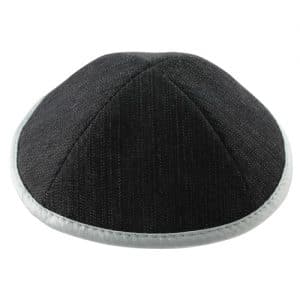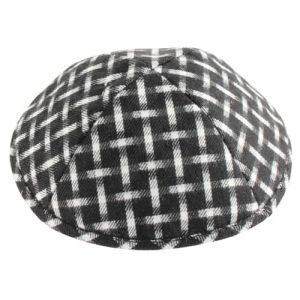No products in the cart.
Yarmulke - Kippah - Kippot - Yamaka
-
-
Black crocheted Kippa – big (22 cm)
Big Handmade black crochet Kippa (22 cm)
$20.00$26.00Black crocheted Kippa – big (22 cm)
$20.00$26.00 -
-
Black Kippa Cloth (18 cm)
High-quality cloth Kippa in a unique black color. With a dedicated place for a pin, on the inside of the Kippa. 18 cm in size
$5.00$8.00Black Kippa Cloth (18 cm)
$5.00$8.00 -
Olive green Kippa linen (17 cm)
High-quality linen Kippa in a unique Olive green color. With a dedicated place for a pin, on the inside of the Kippa. 17 cm in size
$4.00$6.00Olive green Kippa linen (17 cm)
$4.00$6.00 -
Purple Kippa linen (17 cm)
High-quality linen Kippa in a unique purple color. With a dedicated place for a pin, on the inside of the Kippa. 17 cm in size
$4.00$6.00Purple Kippa linen (17 cm)
$4.00$6.00 -
Blue Kippa Cloth (18 cm)
High-quality cloth Kippa in a unique blue-gray color. With a dedicated place for a pin, on the inside of the Kippa. 18 cm in size
$5.00$8.00Blue Kippa Cloth (18 cm)
$5.00$8.00 -
Jeans Kippa – Black with gray stripe (17 cm)
A high-quality 17 cm denim Kippa with room for a pin on the inside of the Kippa. in Black shade with gray stripe on the outside
-
Velvet Kippa with ribbon (size 2)
4 piece velvet Kippa with ribbon, size 2
$6.00$8.00Velvet Kippa with ribbon (size 2)
$6.00$8.00 -
Cloth Kippa -White Points on black (19 cm)
Top-quality black cloth Kippa with White Points. With a dedicated place for a pin, on the inside of the Kippa. 19 cm in size
$4.00$6.00Cloth Kippa -White Points on black (19 cm)
$4.00$6.00 -
Cloth Kippa -White stripes on black (17 cm)
Top-quality black cloth Kippa with White stripes. With a dedicated place for a pin, on the inside of the Kippa. 17 cm in size
$4.00$6.00Cloth Kippa -White stripes on black (17 cm)
$4.00$6.00 -
Purple Kippa linen (19 cm)
High-quality linen Kippa in a unique purple color. With a dedicated place for a pin, on the inside of the Kippa. 19 cm in size
$4.00$6.00Purple Kippa linen (19 cm)
$4.00$6.00 -
Cloth Kippa -White stripes on Azure (17 cm)
Top-quality Azure cloth Kippa with White stripes. With a dedicated place for a pin, on the inside of the Kippa. 17 cm in size
$4.00 -
Cloth Kippa -gray stripes on gray (19 cm)
Top-quality gray cloth Kippa with gray stripes. With a dedicated place for a pin, on the inside of the Kippa. 19 cm in size
$4.00$6.00Cloth Kippa -gray stripes on gray (19 cm)
$4.00$6.00 -
Cloth Kippa -White stripes on blue (19 cm)
Top-quality blue cloth Kippa with White stripes. With a dedicated place for a pin, on the inside of the Kippa. 19 cm in size
$4.00$6.00Cloth Kippa -White stripes on blue (19 cm)
$4.00$6.00 -
Cloth Kippa – blue Triangles (17 cm)
Top-quality white cloth Kippa with blue Triangles Illustrations. With a dedicated place for a pin, on the inside of the Kippa. 17 cm in size
$4.00$6.00Cloth Kippa – blue Triangles (17 cm)
$4.00$6.00 -
Large Mikraot Gedolot set – with embellished leather cover
A large Mikraot-Gedolot set of five Torah Chumash’s, in large (25 * 17 cm), in leather binding with impressive embellishments. You can add a personal stamp plus a fee. A great and honorable gift for a bar mitzvah or similar family event.
$650.00$660.00Large Mikraot Gedolot set – with embellished leather cover
$650.00$660.00 -
Velvet Kippa with ribbon (size 6)
6 piece velvet Kippa with ribbon
$6.00$8.00Velvet Kippa with ribbon (size 6)
$6.00$8.00 -
Velvet Kippa with ribbon (size 5)
6 piece velvet Kippa with ribbon
$6.00$8.00Velvet Kippa with ribbon (size 5)
$6.00$8.00 -
Velvet Kippa with ribbon (size 8)
6 piece velvet Kippa with ribbon
$6.00$9.00Velvet Kippa with ribbon (size 8)
$6.00$9.00 -
Bukhari Kippa (52 cm) in many shades
Large cloth Kippa covering the entire head (52 cm), with oriental style embroidery. Available in a variety of colors.
$5.00$8.00Bukhari Kippa (52 cm) in many shades
$5.00$8.00 -
White Kippa – “White Light” – with silver rhombus
Satin white skullcap, combined with silver rhombus embroidery. (15 cm)
$3.50$5.00 -
Large Kippa – thick knitting – white and black (20 cm)
Large Kippa (20 cm) thick knitting (‘Mitnachlim’ style) in white and black shades
$5.00$8.00
the significance of the kippah, also known as a yarmulke, in Jewish culture. The kippah is a small, circular head covering worn by Jewish men as a symbol of their faith and a reminder of the presence of God. The purpose of this article is to provide an in-depth understanding of the kippah, its history, its significance, and its importance in Jewish culture.
History of the Kippah:
The kippah has been a part of Jewish tradition for thousands of years. The earliest mention of a head covering in Jewish scripture dates back to the book of Samuel, where it is mentioned that David wore a hat on his head. However, the specific type of hat or head covering was not mentioned. It was not until the Talmudic period, around the 5th century CE, that the kippah as we know it today, began to emerge.
The kippah was originally worn as a sign of respect and humility before God. It was also worn as a symbol of Jewish identity and a reminder to Jews that God is always present above them. Today, the kippah is widely recognized as a symbol of Jewish faith and is worn by Jewish men of all ages.
Significance of the Kippah:
The kippah is a physical symbol of a Jew’s commitment to their faith. It serves as a reminder that God is always present and watching over them. The wearing of a kippah also signifies that a Jew is a part of the larger Jewish community, and that they are bound by the same traditions and beliefs as other Jews.
The kippah is worn during prayer, study, and during other religious activities. It is also worn during everyday activities as a sign of Jewish identity and a commitment to one’s faith. In many Orthodox communities, men are required to wear a kippah at all times, while in more liberal communities, the wearing of a kippah is a personal choice.
Different Types of Kippahs:
There are several different types of kippahs that are worn by Jewish men. The most common type is a simple, small, circular cloth or crocheted kippah. However, kippahs can also be made from a wide range of materials, including leather, suede, velvet, and even metal.
Some communities have specific customs regarding the type of kippah that should be worn. For example, many Orthodox Jews prefer black velvet kippahs, while others may prefer a colorful crocheted kippah. Ultimately, the type of kippah that is worn is a matter of personal preference and community tradition.
Conclusion:
The kippah is a small but significant symbol of Jewish identity and faith. It serves as a reminder to Jews that God is always present and watching over them, and it signifies a commitment to Jewish tradition and beliefs. Through the wearing of the kippah, Jewish men are able to connect with their faith and with other members of the Jewish community.
In conclusion, we hope that this article has provided a comprehensive understanding of the kippah, its history, significance, and importance in Jewish culture. We encourage all Jewish men to consider wearing a kippah as a way of expressing their faith and identity, and as a reminder of the presence of God in their lives.
Yarmulke – Kippah, Yamaka
Covering the head is a religious commandment in faiths such as Islam. Judaism also has the concept of covering the head, but it is not religious compulsion. It is worn during prayer or when visiting a place of worship. The skullcap worn by the Jews is called a Yamaka. It is an important symbol of Jewish identity after the Star of David. It has been worn by Jewish men and young boys traditionally. In modern times ladies wear one too as a reaffirmation and reminder of their faith. One often hears a Yamaka being referred to as a “Kippah.” kippah is the Hebrew name for this Jewish hat (כיפה).
Religious Significance of the Yamaka
The Yamaka is a symbol of humility and reverence. Wearing it signifies acknowledgment of a higher authority. It is a reminder that the Almighty keeps a watch on all from above. The custom of covering the head with a skull cap also implies that one is a servant of God.
A passage in the Talmud (Shabbat 156b) instructs its followers to cover their heads. It reads, “Cover your head so that the fear of heaven may be upon you.” There are more references in the Jewish religious commentary.
When do you wear a Yamaka?
Most Jews usually wear a Yamaka when praying or studying the Torah as a sign of respect for God. However, some devout Jews wear this religious head covering throughout the day as a symbol of true devotion to God. Some Jews, those who don’t actively practice the faith, put on a Yamaka occasionally. The occasional events include weddings, funerals and other religious functions. They wear it so as to identify themselves with this religious sect.
What age do you wear a Yamaka?
Jewish children start wearing a Yamaka at the age of 3. At this age, they have their first haircut and also start wearing another easily recognizable religious symbol “tzitzit”. The ceremony is called “upsherin”. Upsherin also marks the beginning of formal Torah education.
Covering the head is a widely followed Jewish tradition. However, like already mentioned above it is not a commandment or a religious obligation. One can go without a Yamaka if his immediate surroundings or situation demands it. For example, you might not be allowed to put on a cap at work. The compulsion factor also depends upon the synagogue one attends.
Types and Designs
The KIPPAH is a small hemispherical cap. It measures 5 inches in diameter. The yarmulke is worn at the apex of the head. It is fitted to the head using hair clips or bobby pins. Many have inbuilt combs to help hold the cap in place. Designs for infants are fitted with ribbon-like ties to secure the cap under the chin.
Earlier, all Yamakas were black and were made of a velvet material with the “Star of David” symbol embroidered on it. However, today religious revolution has allowed for variations in its design, color, and material. Although considered a part of male religious attire, many women have started wearing a Yamaka too. Yamakas for women has lace adornments, beadings, crystals, lace trimmings, and other feminine decorations. They are made in brighter colors. Children’s designs are adorned with baseball emblems and cartoon characters too. Modern caps are crocheted, knitted or made of leather.





















